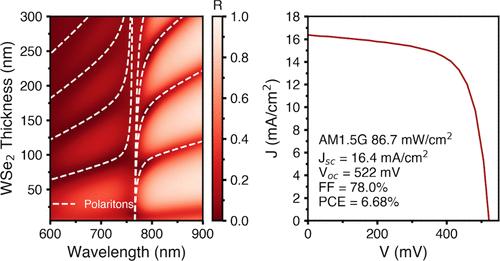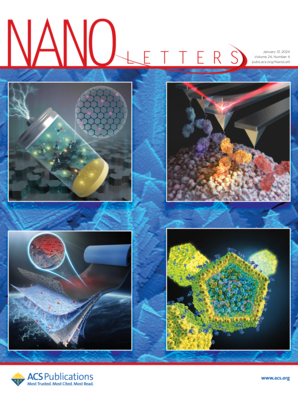Effects of Self-Hybridized Exciton-Polaritons on TMDC Photovoltaics
IF 9.1
1区 材料科学
Q1 CHEMISTRY, MULTIDISCIPLINARY
引用次数: 0
Abstract
Hybrid light-matter states called exciton-polaritons have been explored to improve excitonic photovoltaic (PV) and photodiode efficiency, but the use of closed cavity structures results in efficiency gains over a narrow band, with losses in the short circuit current density under solar illumination. In WX2 (X = S, Se), the simultaneous large optical constants and strong exciton resonance can result in self-hybridized exciton-polaritons (SHEPs) emerging from the strong coupling of excitons and optical cavity modes formed by WX2. We perform thickness dependent device characterization of WS2 and WSe2 PVs to show that self-hybridized strong coupling enhances device efficiency on resonance while still enabling broadband absorption, resulting in improved short circuit current density under solar illumination. Ultimately, we leverage strong coupling to achieve external quantum efficiencies as high as 70% and record power conversion efficiencies approaching 7%. This result indicates the utility of SHEPs for light-energy harvesting applications.

自杂化激子极化子对TMDC光伏的影响
为了提高激子光伏(PV)和光电二极管的效率,已经探索了称为激子-极化子的混合光物质状态,但是使用闭合腔结构会导致效率在窄频带内提高,而在太阳照射下短路电流密度会损失。在WX2 (X = S, Se)中,由于同时存在较大的光学常数和强激子共振,由WX2形成的激子与光腔模式的强耦合产生了自杂化激子-极化子(SHEPs)。我们对WS2和WSe2 pv进行了厚度相关的器件表征,表明自杂化强耦合提高了器件的共振效率,同时仍能实现宽带吸收,从而提高了太阳光照下的短路电流密度。最终,我们利用强耦合实现高达70%的外部量子效率和接近7%的创纪录功率转换效率。这一结果表明shps在光能收集应用中的实用性。
本文章由计算机程序翻译,如有差异,请以英文原文为准。
求助全文
约1分钟内获得全文
求助全文
来源期刊

Nano Letters
工程技术-材料科学:综合
CiteScore
16.80
自引率
2.80%
发文量
1182
审稿时长
1.4 months
期刊介绍:
Nano Letters serves as a dynamic platform for promptly disseminating original results in fundamental, applied, and emerging research across all facets of nanoscience and nanotechnology. A pivotal criterion for inclusion within Nano Letters is the convergence of at least two different areas or disciplines, ensuring a rich interdisciplinary scope. The journal is dedicated to fostering exploration in diverse areas, including:
- Experimental and theoretical findings on physical, chemical, and biological phenomena at the nanoscale
- Synthesis, characterization, and processing of organic, inorganic, polymer, and hybrid nanomaterials through physical, chemical, and biological methodologies
- Modeling and simulation of synthetic, assembly, and interaction processes
- Realization of integrated nanostructures and nano-engineered devices exhibiting advanced performance
- Applications of nanoscale materials in living and environmental systems
Nano Letters is committed to advancing and showcasing groundbreaking research that intersects various domains, fostering innovation and collaboration in the ever-evolving field of nanoscience and nanotechnology.
 求助内容:
求助内容: 应助结果提醒方式:
应助结果提醒方式:


